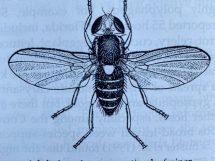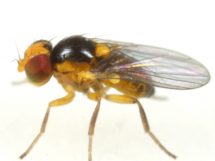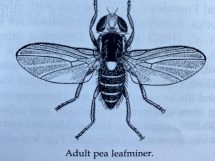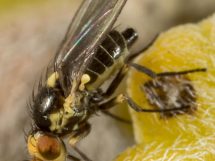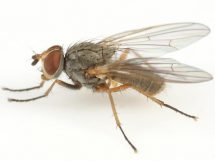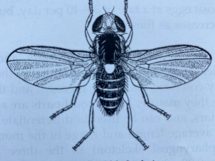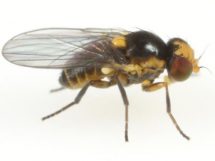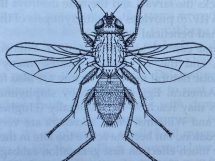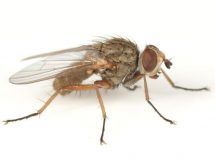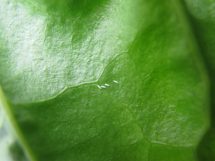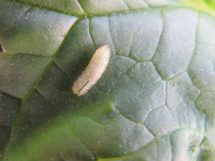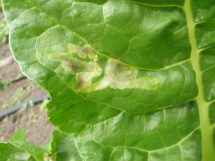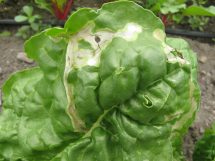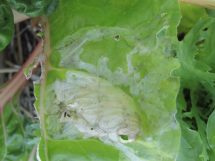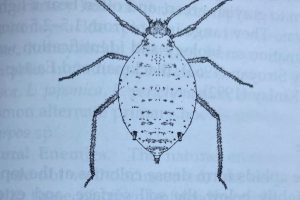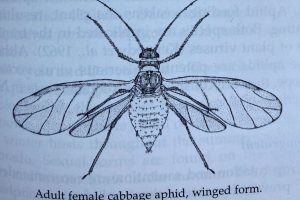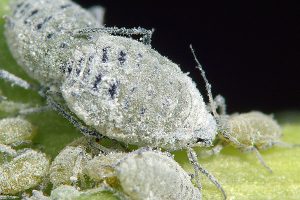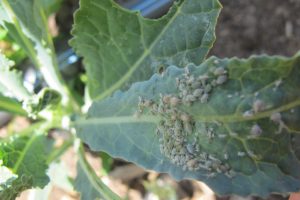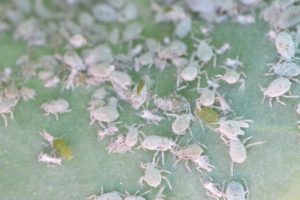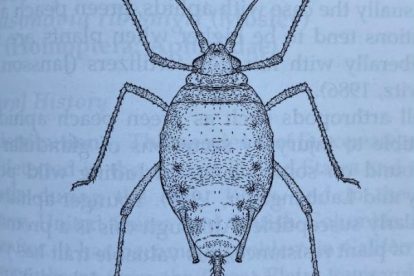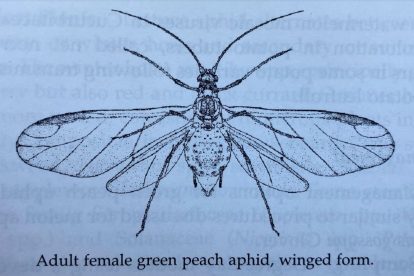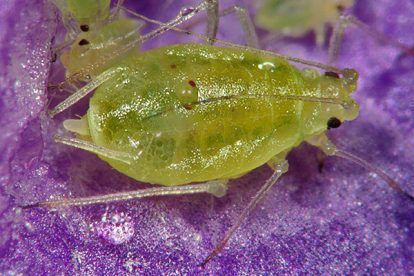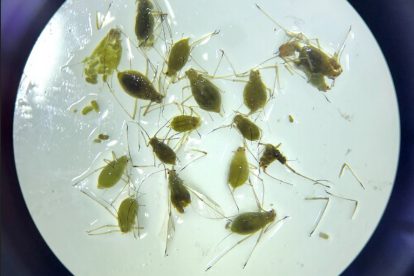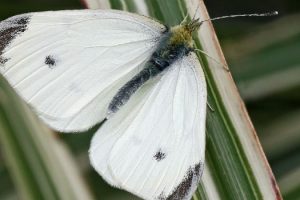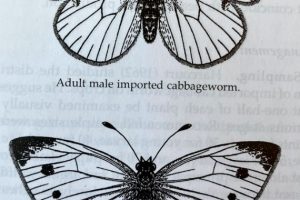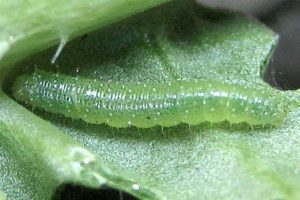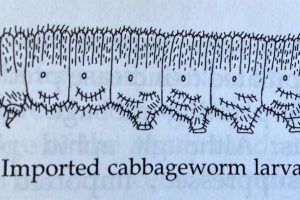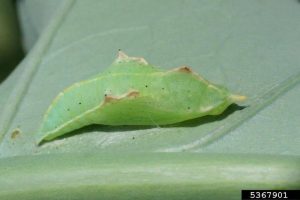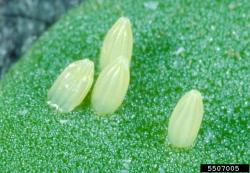In this Issue:
- Leafminers
- Cabbage Aphids
- Green Peach Aphids
- Imported Cabbageworm
LEAFMINERS
Occurrence: Active Now, First-generation adults are emerging early this year. Examine your cool-season leafy greens (spinach, peas, beets, chard, collards, etc.).
Description: Adults are small (0.06-0.33 inch long), black-gray flies with yellow-green markings depending on the species. Eggs are about 0.04 inches long and 0.0008 in wide, white, elongate, cylindrical, and laid singly or in small groups. The larvae (maggots) are legless, initially colorless but becomes yellowish as it matures with four instars ranging from 0.02-1.0 inch long.
Regularly check young seedlings for leaf mines. Most mines occur on cotyledons and the first true leaves. It is not necessary to treat leafminers that are feeding on leaves of root crops such as beets, where the edible portion is not affected. However, leafminers on spinach or leafy greens may require management.
Management:
- Inspect leaves. Find egg masses throughout the growing season and crush them.
- Clip and remove infested leaves.
- Gently cultivate the soil. Around the plants to uncover pupae and destroy any that are found.
- Use adequate irrigation. This keeps plants healthy.
- Eliminate alternate hosts. Destroy weeds and deep plow or physically remove crop residues which can be food and overwintering sources for leafminers.
- Encourage parasitic wasps. Plant flowering plants with nectar and pollen-rich umbel-type flowers with shallow cups, such as yarrow, dill, and fennel.
- Cultivate the soil in late fall. Expose overwintering pupae to the colder temperatures that will kill them.
Insecticide applications help prevent adults from laying eggs, but they do not kill larvae that are already feeding within the plant leaves. Choose low-impact insecticides such as spinosad, when possible to reduce impacts on natural enemies. If insecticides are necessary, the time to treat is on the eggs as they hatch. Make sure to get good coverage on the leaves.
Generally, leafminer numbers are strongly suppressed by natural predators, and outbreaks are usually associated with the use of insecticides. Several parasitic wasps and predators, including vespid wasps (yellow jacket and European paper wasp) and predatory thrips, will attack leafminers.
Effective home-use insecticides registered for leafminer control in Utah.
| Active Ingredient | Products |
| carbaryl | Garden Tech Sevin 5% Dust Bug Killer |
| malathion | Spectracide Malathion, Ortho Malathion |
| cyfluthrin | BioAdvanced Vegetable and Garden Insect Spray |
| permethrin | Bonide Eight Vegetable, Fruit & Flower |
| pyrethrins | Monterey Bug Buster-O, Worry-Free Insecticide |
| zeta-cypermethrin | GardenTech Sevin |
| pyrethrins + insecticidal Soap | Safer Brand Tomato & Vegetable Insect Killer |
| spinosad | Monterey Garden Insect, Bonide Captain Jack’s Deadbug, Natural Guard Spinosad Spray |
| oils: plant-based | Natural Guard Neem Spray, Monterey Neem Oil, Garden Safe Neem Oil |
| azadirachtin | Safer BioNeem |
CABBAGE APHIDS
Occurrence: Active Now, Carefully inspect your broccoli, cauliflower, cabbage, kale, collards, kohlrabi, radish, and kale.
Description: Cabbage aphids are usually green in color but can often appear gray due to a grayish, waxy covering produced by the insect that is used for protection. This species also has short cornicles. Individuals can measure from 0.07 to 0.1 in (1.8 to 2.5 mm) long.
Cabbage aphids do not require an alternation of host plants. In northern Utah, they overwinter as eggs on crop debris, and in southern Utah, they may overwinter as adults. In spring, eggs hatch to all females, and reproduction occurs as noted above on mustard family plants. Winged aphids form when colonies become too crowded, resulting in dispersal to other brassica hosts. Cool fall temperatures cause sexual mating and egg-laying for overwintering.
GREEN PEACH APHIDS
Occurrence: Active Now, Carefully inspect your vegetable transplants and nearby woody hosts (check budding new growth)
Description: Summer forms are often green-yellow and can be pale to vibrant. Fall forms can be green to pink or red. Winged forms often have some black coloration on the top of their bodies. Size can range from 0.06 to 0.09 in (1.5 – 2.3 mm).
Green-peach aphids require a woody host to complete their life cycle. They overwinter as eggs on woody hosts and hatch in spring, producing only females. These spring aphids feed on the succulent new growth, and when mature, give birth asexually (parthenogenesis) to live female offspring. As the weather warms (70-81°F is optimal), aphids can complete a generation in as little as 7-8 days. Females can produce up to 12 nymphs per day for 50-100 total offspring. After 2-6 generations on the woody hosts, the aphids form wings and migrate to vegetable crops and other hosts for the summer, where they complete many more generations. As temperatures cool in the fall, aphids again form winged offspring (male and female) and return to winter host plants, where sexual mating occurs and eggs are laid for overwintering.
Aphid Management:
One of the most serious problems caused by aphids to vegetable crops is the spread of plant viruses. Viruses can dramatically reduce crop yield, and even kill plants. The green peach aphid can transmit common vegetable viruses like Alfalfa Mosaic Virus, Cucumber Mosaic Virus, Potato Virus Y, and Watermelon Mosaic Virus.
- Visually inspect plants for aphid colonies, feeding symptoms on growing tips, and curled leaves. Most aphid species prefer the undersides of leaves, so be sure to turn foliage over when scouting. Use a 10-20x hand lens for species identification.
- Look for small white flakes, which are the shedded skins of aphids.
- Yellow sticky traps are effective to monitor for the presence of winged aphids. Place traps 4–6 inches above susceptible host plants.
- Monitor plants for various symptoms of viruses. Vegetable viruses vectored by aphids include alfalfa mosaic virus, cucumber mosaic virus, potato virus Y, and watermelon mosaic virus.
- Look for a sticky substance called honeydew on leaves’ stems. It is a sugary, sticky secretion from aphids. It can cause the growth of a black sooty mold.
- Monitor for the presence of ants. Ants feed on excreted honeydew from aphids, which can indicate high populations.
- Use preventive measures. Before planting inside the high tunnel, remove weeds and volunteer crops that can serve as aphid hosts.
- Encourage natural enemies. Plant strips of yarrow, alyssum, herbs, and other plants with small, attractive flowers that provide nectar and pollen for beneficial insects.
- Inspect transplants. Before planting in your garden or field examine transplants for aphids.
- Manage nitrogen levels. High levels of nitrogen fertilizers tend to encourage aphid reproduction. Use several, staggered applications of lower concentrations of nitrogen rather than a single high dose. Also, use delayed-release formulations.
- Several natural predators feed on aphids. It is important to scout for these predatory and parasitic insects and eggs in and around your farm and garden. These natural predator populations can maintain aphids at low levels. However, predators will only show up if a food source exists, so there can be a lag time between the appearance of the aphids and the appearance of predators.
Insecticides should only be used when needed. Rotate among different insecticide classes between applications as aphids are prone to developing resistance. Resistance has occurred with pyrethroids for populations of green peach aphid and melon aphid in agriculturally intensive areas of the United States. Some insecticides may kill the beneficial insects mentioned above.
Effective home-use insecticides registered for aphid control in Utah.
| Active Ingredient | Products |
| malathion | Spectracide Malathion, Ortho Malathion |
| cyfluthrin | BioAdvanced Vegetable and Garden Insect Spray |
| gamma-cyhalothrin | Spectracide Triazicide |
| permethrin | Bonide Eight Vegetable, Fruit & Flower |
| pyrethrins | Monterey Bug Buster-O, Worry-Free Insecticide |
| zeta-cypermethrin | GardenTech Sevin |
| pyrethrins + insecticidal Soap | Safer Brand Tomato & Vegetable Insect Killer |
| spinosad | Monterey Garden Insect, Bonide Captain Jack’s Deadbug, Natural Guard Spinosad Spray |
| oils: plant-based | Natural Guard Neem Spray, Monterey Neem Oil, Garden Safe Neem Oil |
| oils: mineral oil | Bonide All Season Spray Oil, Monterey Horticultural Oil |
| potassium salts of fatty acids (insecticidal soap) | Safer 3-in-1 Garden Spray, Natria Insecticidal Soap |
IMPORTED CABBAGEWORM
Occurrence: Active Now, The first generation of adult butterflies are out now, they can be seen flying out about near wild mustard hosts or in garden settings where brassica crops have been planted already.
Description: Adults are white butterflies with a wingspan of about 1.75 inches. Males have one pair of black spots on their wings, while females have two pairs. Eggs are laid singly, usually on the outer leaves of the plant. They are bullet-shaped with longitudinal ridges. The larva is green, velvety in appearance, and bears five pairs of prolegs. Larvae develop through five instars before reaching maturity. The Pupae is green in color with yellow stripes on the back and sides; there is no outer cocoon.
Imported cabbageworm overwinter as pupae near host plant debris and emerge as adults in mid-spring. Eggs are laid on the undersides of outer leaves and hatch after 4-8 days. Larvae mature after 2-3 weeks and pupate on the host plant. Pupation takes 1-2 weeks and emerged adults mate and lay eggs for a second generation. One generation takes about 3-6 weeks from egg to adult and 3-5 generations can occur each year.
Imported cabbageworm prefers broccoli, cabbage, and cauliflower, but will feed on all cole crops. Larvae feed on outer leaves, resulting in round holes. Frass (excrement) can stain or discolor broccoli and cauliflower heads. As crop heads develop, imported cabbageworm feed on outside leaves and bore into heads, resulting in unmarketable produce.
Management:
- Scout weekly. Start at the button stage (before cauliflower and broccoli heads begin to elongate and expand). Pull 10 leaves from 10 different plants at 10 different locations of the field to a total of 100 leaves. Look for small larvae and eggs on the undersides of leaves and larger caterpillars toward the center of the plant or near the midribs of leaves. Watch for the white butterflies flying during the day. Scout for other caterpillars at the same time.
- Plant cabbage as an early crop. Harvest before cabbageworm populations builds to damaging levels.
- Plant resistant varieties to lessen cabbageworm damage. Resistant varieties include: ‘Mammoth’, ‘Red Rock’, ‘Chieftan Savoy’, and ‘Savoy Perfection Drumhead’.
- Harvest as early as possible and destroy or plow under plant residues.
- Rotate crops and distance susceptible hosts from current and previous susceptible crop plantings.
- Use row covers to exclude butterflies from laying eggs on host plants. Remove covers during flowering for pollination.
- Natural enemies can be a major contributor to reductions in cabbageworm populations. Trichogramma wasps and tachinid flies parasitize cabbageworm eggs, pupae, and larvae. Commercially purchased Trichogramma can be released at the peak flight of cabbageworm as an effective form of control.
- If 2 or more medium-sized larvae are found per 10 leaves at the button stage, two sprays will be needed: 1) a spray at the button stage and 2) a clean-up spray 7-10 days before harvest.
Effective home-use insecticides registered for imported cabbageworm control in Utah.
| Active Ingredient | Products |
| carbaryl | Garden Tech Sevin 5% Dust Bug Killer |
| cyfluthrin | BioAdvanced Vegetable and Garden Insect Spray |
| gamma-cyhalothrin | Spectracide Triazicide |
| permethrin | Bonide Eight Vegetable, Fruit & Flower |
| pyrethrins | Monterey Bug Buster-O, Worry-Free Insecticide |
| zeta-cypermethrin | GardenTech Sevin |
| pyrethrins + insecticidal soap | Safer Brand Tomato & Vegetable Insect Killer |
| pyrethrins + sulfur | Bonide Tomato and Vegetable 3 in 1, Natria Insect Disease & Mite Control, Ortho Insect Mite & Disease 3 in 1 |
| Spinosad | Monterey Garden Insect Spray, Bonide Captain Jack’s Dead Bug, Natural Guard Spinosad Spray |
| Bacillus thuringiensis | Bonide Thuricide, Garden Safe Caterpillar Killer with Bt, Natural Guard Caterpillar Killer with Bt, Dipel Dust, Garden safe Bt worm, and Caterpillar Killer |

